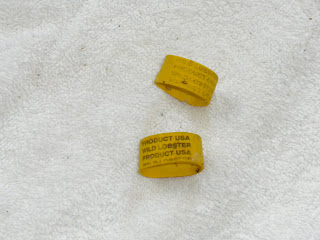8743 A1 0037 ME 07 EEZ Z:G
??13 A1 0645 ME 08 Z:F
0003369 ME 03 NC
???? A1 0189 ME 09 Z:G EEZ
846 ME 00 EEZ
3754 0445 ME 02 EEZ
???? 0344 ME ?? ????
72595 0754 ME 03 EEZ
No, your Web browser isn't freaking out. The codes above come from plastic tags attached to derelict lobster traps, washed up along the shores of Ocean Park.
These hulks litter the beach. As well as hundreds of pounds of rope and shredded bits of metal caging hopelessly tangled amid the carcasses.
So far I've found more than a dozen relatively intact ones, and dozens more scraps and shreds (which admittedly required walking some 7 to 8 blocks instead of 2). The true scale is probably much greater, as the sands are expert at hiding the sharp, rusted, twisted remains.
Each one of these crumpled, crushed, and torn boxes tells a story. As do the codes on the tags. After some digging, I've learned how to decipher them, largely. Let's take a complete one:
8743 A1 0037 ME 07 EEZ Z:G
8743 is the owner's license #.
A1 is the American Lobster Management area for MA/ME.
0037 is (I believe) the trap #.
ME 07 says the tag was registered for the year 2007.
EEZ = "Exclusive Economic Zone" - a zone 12-200 mi. from shore.
Z:G is Maine's zone G -- from NH border to roughly Portland.
What's striking is how many of these traps come from EEZ -- that is, at least 12 miles off the coast. One can imagine the tortured tale. Each of these traps at some point tore free from its buoy, then scraped and rolled along the seabed until eventually washing up on shore -- in at least one case (ME 00) seemingly a decade-long trip! It's sobering to consider how many more are in the deeps, waiting their turn.
What else struck me was -- why are they still here? These rotting, dangerous, disintegrating hulks are still there at the beach, visit after visit. Why doesn't anyone take them away?
It turns out, it's illegal. According to Title 12, Part 9, Subpart 2, Chapter 619, Subchapter 2 of Maine's Statutes, it is an offense to remove a trap from the beach without getting written permission from the Commissioner of Marine Resources first. A law originally meant to keep lobstermen from hassling each others' traps could now result in up to $6000 in fines for removing a dozen derelict and broken traps currently fouling a beautiful beach.
How safe do you feel, knowing that this might be under your daughter's feet?































